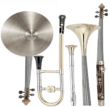3.1 Orchestration methods: Layout
The orchestration methods presented in this book are organized into two chapters. In the first chapter, the focus is on the texture, particularly the non-instrumental texture, placed within the soundspace. This involves decisions about (1) which instruments participate (the distribution of instruments), (2) how they contribute to the realization of elements (the continuity in the use of instruments), and (3) the positioning of elements in relation to each other along axes of height and low (the octave the elements are playing in) versus front and back (how the elements are arranged in relation to each other).
The subsequent chapter introduces doublings. Doublings can modify and alter perspectives on timbre, dynamics, articulation, etc., without changing the number of elements in the texture. Doublings may thus be viewed as a layer within the layout, although they certainly have the power to modify the layout. This chapter explores the concept of doubling as more of the same and provides an overview of the most important methods for doubling.
3.2 Instrument distribution and segments
Orchestration is very much about utilizing the many different possibilities in the forces employed. Changing between soli and tutti, combining instruments into groups, and economizing with the resources are at the heart of orchestration. The distribution of instruments refers to the assignment of specific instruments to varying textures within a musical composition. This distribution subdivides the overall orchestration into segments, where each segment involves the continuous use of a selected group of instruments.
In general, the instrument distribution tends not only to follow the change in texture, but also to keep a consistent group of instruments on each element in the texture as exemplified in figure 13.
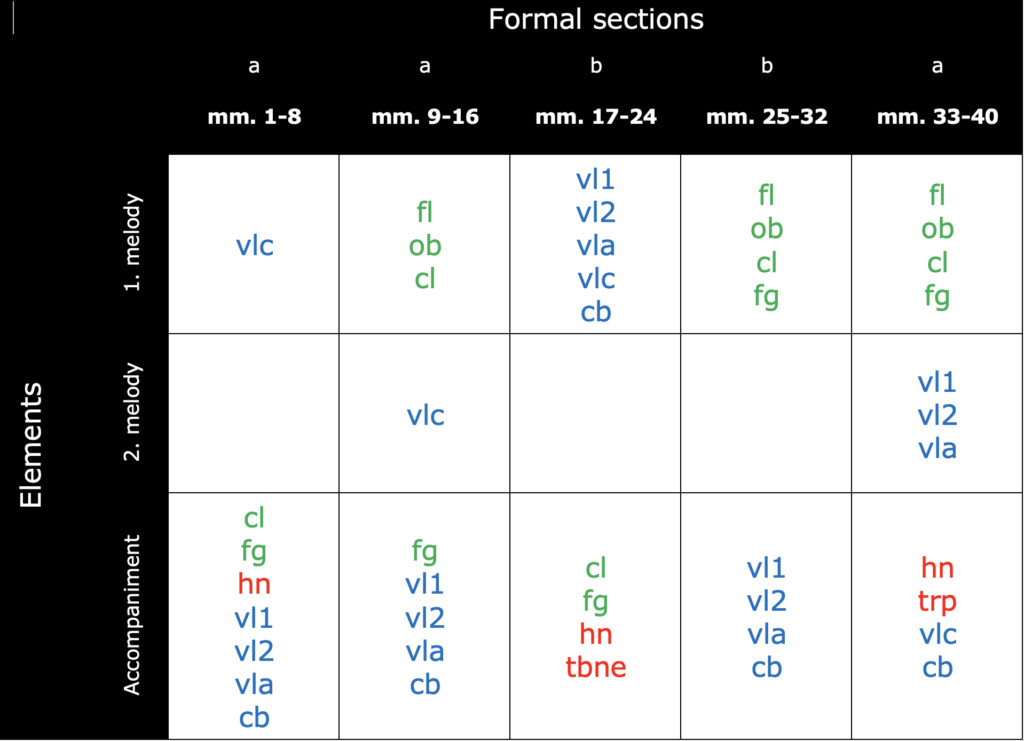
Figure 14. Instrument groupings amongst the three textural elements during the first five sections of Tchaikovsky’s Symphony No. 6, 2nd movement. The colors refer to sections of the orchestra (green: woodwinds; red: brass; blue: strings).
The alignment of changing texture and instrumentation, as shown in Figure 13, supports the musical form. Futhermore the distinct instruments used in each element clarify the subdivision of textures into elements.
However, the mirroring of changing texture and the coloring of each element may not always be as clear-cut. The strategy for segmentation, in order to map out the instrument distribution, is therefore to identify sections in which the ideally constant use of instruments remains unchanged, leaving substantial changes in the combination of instruments as markers for new segments.
Orchestration methods, as they will be presented from here onwards, mainly focus on methods used within a single segment.
3.3 Continuity: Linear and split orchestration
Continuity concerns the relationship between an element and its orchestration within a segment. If an element, e.g., a melody, is orchestrated with one instrument (group) in its entirety, the orchestration method is linear orchestration. On the other hand, if the melody is subdivided into smaller phrases that are passed from instrument (group) to instrument (group), then split orchestration has been used. At the beginning of the 2nd movement of Tchaikovsky’s Symphony No. 6 (Figure 14), the melody in the cellos employs linear orchestration. The accompaniment, conversely, is divided into fragments played by three different groups of instruments in split orchestration.

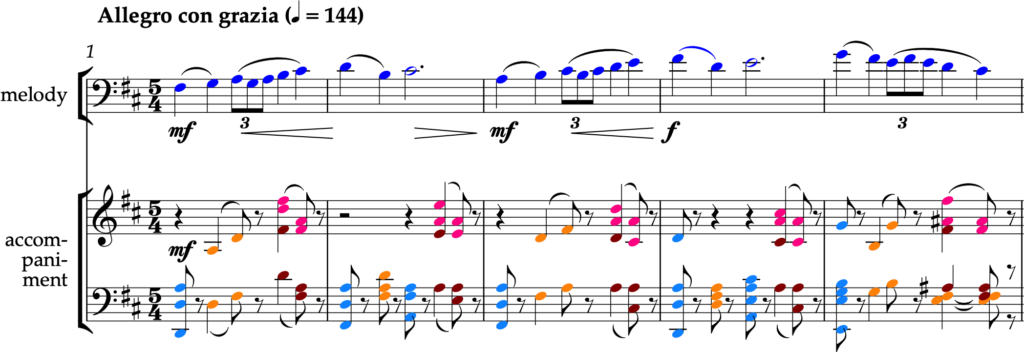
Figure 15. Tchaikovsky Symphony No. 6, 2nd movement. The melody employs linear orchestration whereas the accompaniment employs split orchestration.
Split orchestration as it is used in Fig. 14 activates, dynamizes and colorizes the music, but it can also be used to create a continuous line that goes beyond the range or capacity of the individual instrument (Figure 15).

Figure 16. Ravel’s Rapsodie Espagnole, 2. movement, excerpt. Use of split orchestration to enable a single melody to span a range wider than those of the individual instruments.
Linear orchestration consolidates an element in a texture whereas split orchestration challenges the identity and coherence of an element. Specifically, the latter method can complicate the reading (or, indeed, hearing) of the elements since several instruments must be read (or heard) in sequence to form the element. Spitting between several different groups of instrument in a fast sequence can make it really hard or impossible to identify the textural element.
3.4 Octave position
Octave position is here used as a more abstract term, that, as register, points toward a specific location (an octave, for example C5) but with no regard to weather it might be perceived as heigh or low for the ear or the instruments used.
When reducing an orchestration to a texture (cf. Chapter 2), the octave position of the textural elements may seem fixed, and only up for discussion whenever the reduction involves octave doublings. However, when regarding an orchestration from its compositional perspective, the octave position becomes a creative choice at the same level as choosing the appropriate instruments. A chosen octave position constrains the decision space for choice of instruments and vice versa.
Octave position can have several motivating factors, such as psychoacoustic conditions, the distance between textural elements or the associations linked to a given instrument register.
3.4.1 Psychoacoustics
A given register placement interacts with psychoacoustic conditions constraining our hearing. For example, if played with the same sound pressure level, we experience low frequencies (below 100 Hz) as less powerful than frequencies in the middle and high registers (i.e., 300-10,000 Hz). A 1,000 Hz tone at 20 dB becomes inaudible if its frequency drops to 100 Hz (keeping sound pressure level at 20 dB).
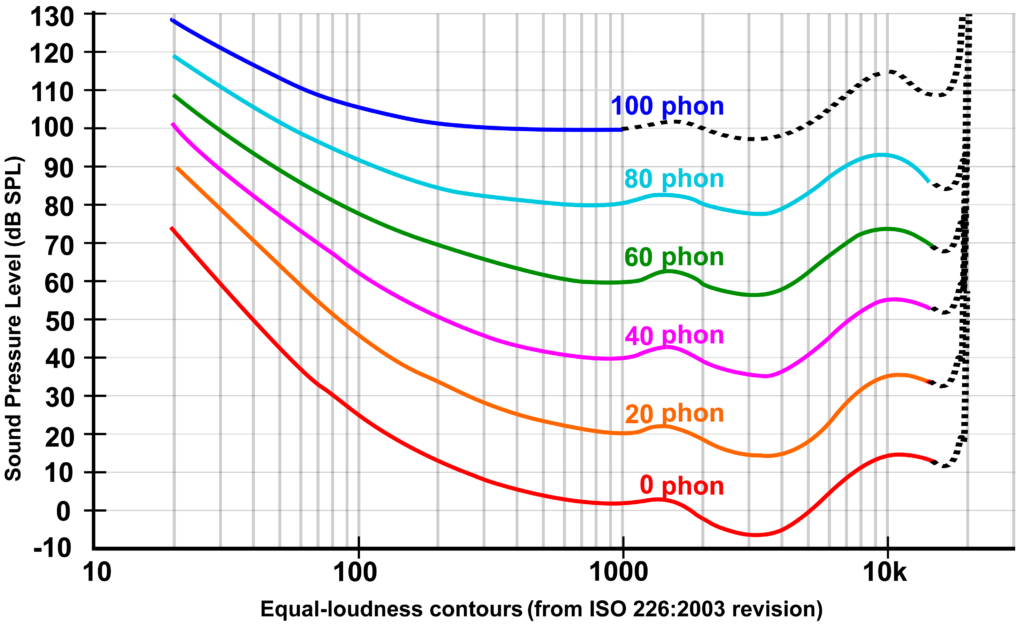
Figure 17. The y-axis marks the sound pressure level in dB, and the x-axis (logarithmic) marks frequency in Hz. The curves indicate which energy level is required at the various frequencies for the frequencies to be perceived as having the same loudness (measured in phons). The Figure is a modified version taken from Wikipedia (CC0).
Consequently, the overtones of low-frequency notes are experienced as louder compared to their fundamentals, than the overtones of high-frequency notes. We hear the clash between the overtones, for example, from a third in a low register as more intense (i.e., more dissonant) than if the same third was placed in a high register. For the same reason, composers of orchestral music typically keep a larger interval (e.g., an octave or more) between co-occurring notes or elements in the bass register compared to the treble register.
3.4.2 The distance between textural elements
The distance between simultaneous textural elements has a great impact on their perceived independence. The closer they are to each other in range and the more similar they are to each other in terms of musical features, the more they will risk interfering with each other. One element may thus mask another. Conversely, the further removed from each other in range and the more musically dissimilar they are from each other, the more easily they will be parsed by the listener as independent elements. Excessive registral space between elements (e.g., two octaves or more) can make it difficult to perceive the coherence between elements. They may ultimately appear unrelated, like two separate pieces of music played simultaneously. Therefore, the use of subtly overlapping registers is often preferred, as in Figure 18 where the melody just touches the top of the accompaniment. However, due to the psychoacoustic constraints described above, bass elements tend to be further separated from their accompanying upper elements.
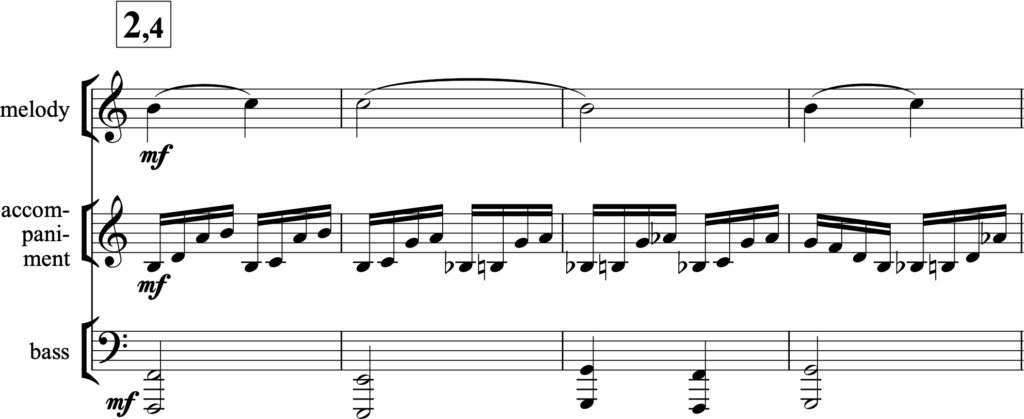
Figure 18. Stravinsky’s Symphony of Psalms, 1st movement. The melody and accompaniment elements utilize subtly overlapping registers whereas the bass element leaves further registral space to its neighbors.
Balancing elements is not only a question of octave position, it also depends on timbre, articulation, dynamics, and doublings. A octave position with high apparent risk of obscurity is found in the previously quoted Tchaikovsky example. Here the melody element (in blue) is surrounded on both sides by the accompaniment, but these two elements are kept separate via a clear difference in timbre and articulation (Figure 19).

Figure 19. Tchaikovsky’s Symphony No. 6, 2nd movement, edited. The melody element (in blue) employs a range overlapping with that of the accompaniment (in gray), but differences in articulation and timbre ensures that the melody can be picked up clearly by the listener.
Octave positions can also be more complicated to evaluate when combined with octave doublings, as is the case just a split second later in the Tchaikovsky example. Here, the accompaniment and melody elements are simultaneously close and far apart from each other due to the doublings over three octaves (see Figure 20).

Figure 20. Tchaikovsky’s Symphony No. 6, 2nd movement. Here, the melody 1 element overlaps in register with the accompaniment and the melody 2 elements. However, it can be clearly heard due to Asits doubling in the upper octave not used by any of the other elements.
3.4.3 Instrument register
Combining octave position with a specific instrument also involves committing to a specific instrument register. Although a given pitch range may sound low or high in the context of our overall hearing range, this perception can be contradicted or magnified by the selected instrument’s relative register. For instance, an E5 played on the piccolo may sound low and relaxed, while the exact same pitch can be perceived as shrill and intense when played on a bassoon. A register that is considered high, in terms of our perception, might be associated with brightness, agility, or a specific gender, but this perception is subject to modification based on the choice of the instrument’s register.
However, the relative registers of the individual instruments should generally not be considered in the registral space between elements. Two textural elements placed in the same octave position cannot be perceptually separated from each other only by placing one element in a high relative register and the other one in a low relative register. Correspondingly, for an element realized with split orchestration, a transfer note between two consecutive instruments will be most convincing if it occurs on the same absolute pitch (i.e., in the same octave), regardless of the relative register of the instruments in question.
3.5 depth position
While octave position delineates the vertical relationships between textural elements, depth position describes their arrangement in terms of being positioned in front of one another or side-by-side. Typically, depth in the sound picture is a result of association, but it can also be realized through the spatialization of the orchestra. Illusions of depth might also be simulated using various playing techniques, such as muted strings, stopped horn, and Schallrichter auf.
3.5.1 Creating depth through textural characteristics
In orchestral music, the most obvious way to position textural elements in a sound picture seems to be through dynamics. However, perceived loudness is not merely a matter of volume. Whether an element occupies the foreground or background of the soundscape depends as much on octave position, transparency, and intensity as on its articulation and musical character, in addition to its dynamic markings. The more penetrating or lively and irregular an element is, the more it grabs the listener’s attention. Conversely, an element dominated by repeating patterns, long notes at an inconspicuous register, and static articulation is easier to overlook and push into the back of one’s mind (more about this in Chapter 6).
Creating a feeling of depth using different types of textural elements, different combinations of instruments and different articulations with the same notated dynamics is a default practice in classical orchestral music as in Figure 21. All three textural elements are in the same dynamic, but the two melodies will appear to be in front of the accompaniment.
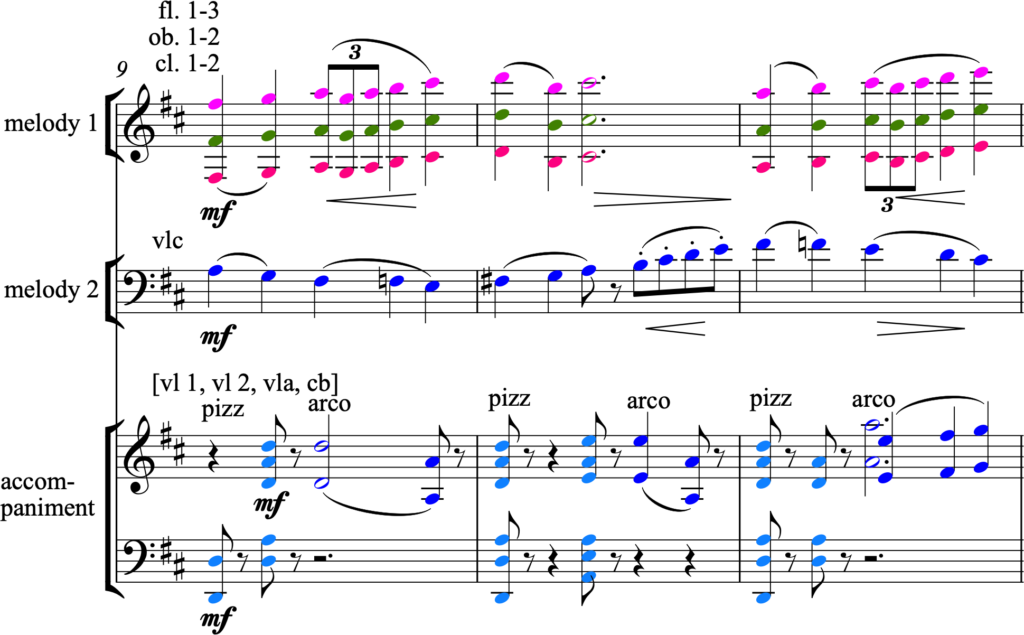
Figure 21. Tchaikovsky’s Symphony No. 6, 2nd movement. All three textural elements are in the same dynamic, but the two melodies will appear to be in front of the accompaniment.
3.5.2 Creating depth through dynamics
The dynamic balance among various textural elements is determined by the choice of instruments and their mutual dynamic versatility. The most obvious way to ensure an even balance is to feature a similar number of instruments from the same instrument family. Conversely, an uneven balance can be achieved by choosing instruments from different families with divergent loudness levels. Additionally, balance can be established through doublings, such as in unisons or octaves (more about doublings in Chapter 4).
Figure 22 exemplifies how different simultaneous dynamics in instruments with radically different dynamic capabilities create a strong sense of depth in the music.
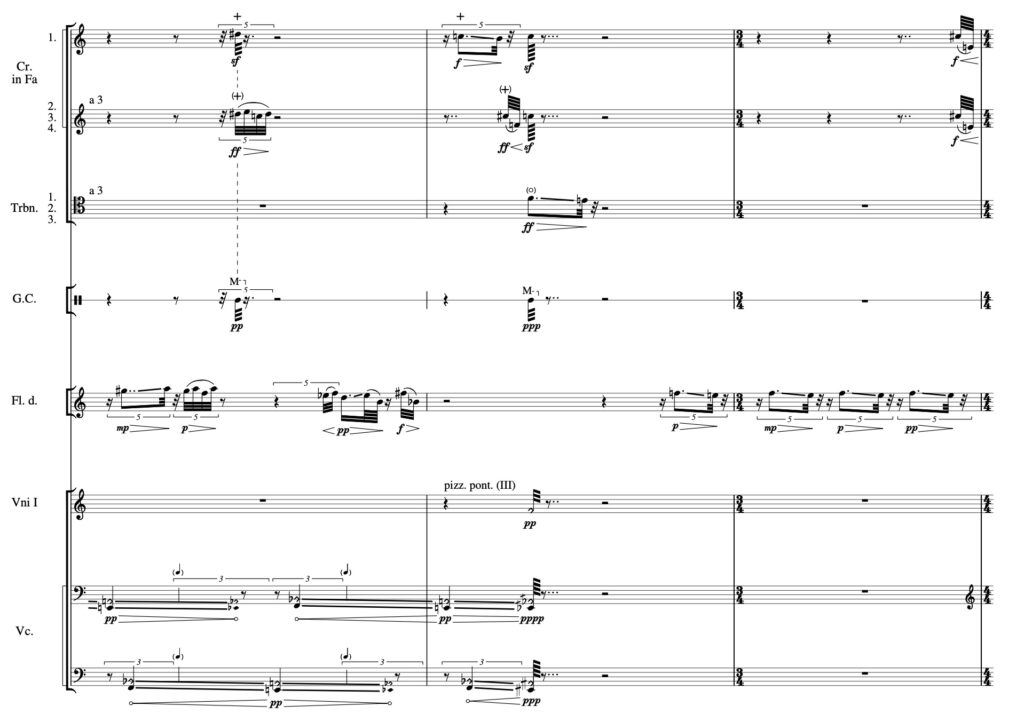
Figure 22. Sciarrino’s 4 Adagi, 1st movement, mm. 36-38. Different simultaneous dynamics in instruments with radical different dynamic cababilities creating a strong feeling of depth in the music.
Notice the radical differences in dynamic capabilities between the the recorder in pp–f and the hornbone in f–ff(sf). Additionally, within a single element, Sciarrino also employs markedly different notated dynamics, as exemplified by the muted pp accent in the bass drum accompanying the ff horns.
3.5.3 Interpretation of dynamic markings
Dynamic markings are always relative to the musical context and the other participating instruments, but ideally written dynamics should reflect the intended dynamic balance. Instruments with the same dynamic markings should seek a mutual balance, irrespective of each instrument’s actual capability.
Composers may engage in the balancing process by adjusting the written dynamics of one instrument in relation to another, considering the dynamic capabilities of each instrument to enhance overall balance. However, this approach introduces a new challenge, as the conductor must interpret the composer’s intentions. The conductor must discern whether the composer actively participated in the dynamic balancing act or left it to the conductor’s discretion.
In general, achieving a specific depth position between textural elements is more feasible when: (1) an orchestration aims for a predictable balance in line with the types and activity levels of the textual elements; or (2) the balance mirrors the dynamic capacity of participating instruments, with or without doublings; or (3) the notated balance aligns with the intended balance.
3.6 Summary
The instrument distribution divides an orchestration into segments, in which long segments give rise to a calm, steady, or even static orchestration, and vice versa.
Within a segment, the featured elements continuity, octave position, and their depth position in the musical foreground and background can be described.
The continuity of a textural element depends on its use of linear or split orchestration method. A linearly orchestrated element is played by one instrument (or one group of instruments) in its entirety. A split-orchestrated element is divided into shoter phrases that are passed between several instruments (or groups of instruments). Linear orchestration supports the identification of the individual textural element whereas split instrumentation makes identification more challenging, but also the music more colorful.
All elements are positioned in a given octave. Elements in the same octave can merge with or mask each other while elements placed too far away from each other can appear unconnected from or unaffected by of each other. Partially overlapping registers are used prominently, and this is often achieved through doublings stretching textural elements across multiple octaves.
The depth position between multiple elements in terms of which ones appear in the foreground and background of the orchestral texture is chiefly determined by the notated dynamics, the choice of instruments and the relative activity levels of the textural elements. Dynamics should generally be read as reflecting the composer’s intended balance, albeit with a keen eye to occasional exceptions from this rule.
